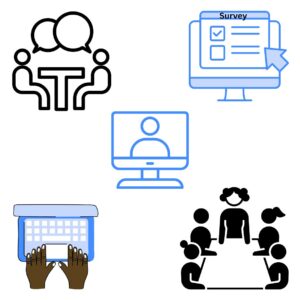Accessible Employee Feedback Mechanisms
An organization's sustainability is rooted in its ability to adapt to its stakeholders' needs. Some of the most important stakeholders are an organization’s team members.
The more authentically engaged team members are, the better the levels of productivity and service delivery. Engagement thrives when high functioning feedback loops are in place.
Organizations can effectively get feedback from teams, take action/no action, and communicate the actions taken/not taken, why, and the results. Engagement and transparent communication offered in a safe space increase levels of trust in the organization, which in turn can increase employees’ willingness to share additional feedback.
To be most effective and to reach all employees, the feedback loops must be accessible. Without accessibility, voices could be missing from the feedback, needs could be misunderstood, and negative impacts could potentially result, for instance lost trust and reduced engagement.
Feedback can come from many sources and in many forms. The more methods you use, the more opportunity there is to receive feedback and to ensure that the message is understood in the context in which it was intended.
Use Multiple Sources of Feedback
Employee engagement thrives when high functioning feedback loops are in place.

- One-on-One Meetings – Open door policies can be the source of important feedback and an opportunity to make a team member feel heard. Some people also prefer to connect directly to discuss their concerns, questions, and other issues on their mind. One-on-one meetings offer you the opportunity to ask questions to clarify any points and can help to build rapport and trust.
- Electronic Surveys and Forms – Electronic surveys and forms can be useful in getting feedback anonymously, taking pressure off team members who may feel singled out. Electronic feedback can also be convenient for employees, as long as the format is accessible and organizations ensure all employees have access to the needed technology. Text-to-speech and dictation compatibility should be considered.
- In-Person Sessions – Larger in-person sessions (open door meetings, group feedback sessions, etc.) allow for visible and supported communications. Some people will feel secure in voicing their concerns where they feel supported or see another person express a similar concern. A safe, open dialogue is an opportunity to hear from the group about improvements that can be made.
- Virtual Sessions – Where in-person meetings are not possible, feedback sessions can be held virtually. Virtual meetings can be more accessible for employees who are off site and for those who wish to contribute but who find crowds and/or stimuli challenging.
- Written Communications – Written communications offer the opportunity to express a concern or ask a question in a way and at a time that suits the employee. For some people, written feedback is an easier way to clearly express thoughts and ideas, and it can be read by the receiver at a more convenient time.
No single method can ensure a completely accessible feedback loop. Combining methods will increase both the accessibility of the feedback loop and the number of effective responses—increasing the number of authentic connections with your team members.
Giving team members options to communicate in the way that is easiest and most comfortable for them will help to promote engagement and to build trust.

